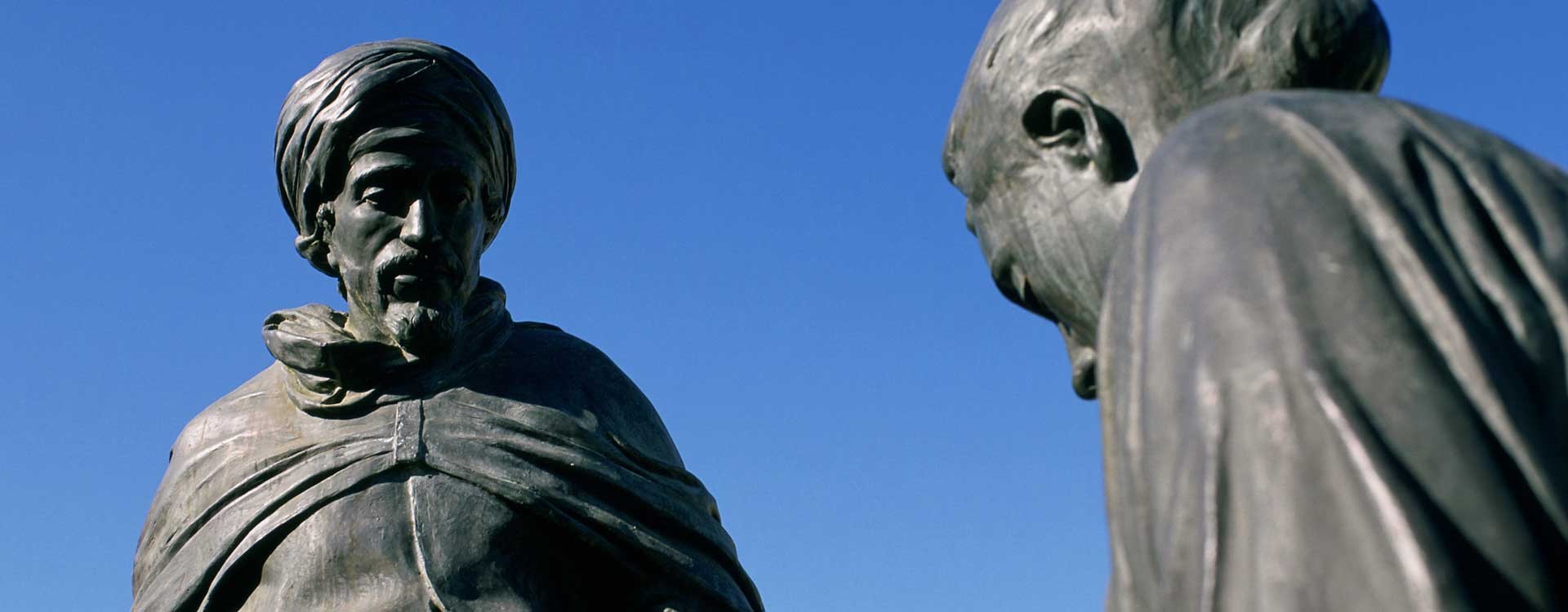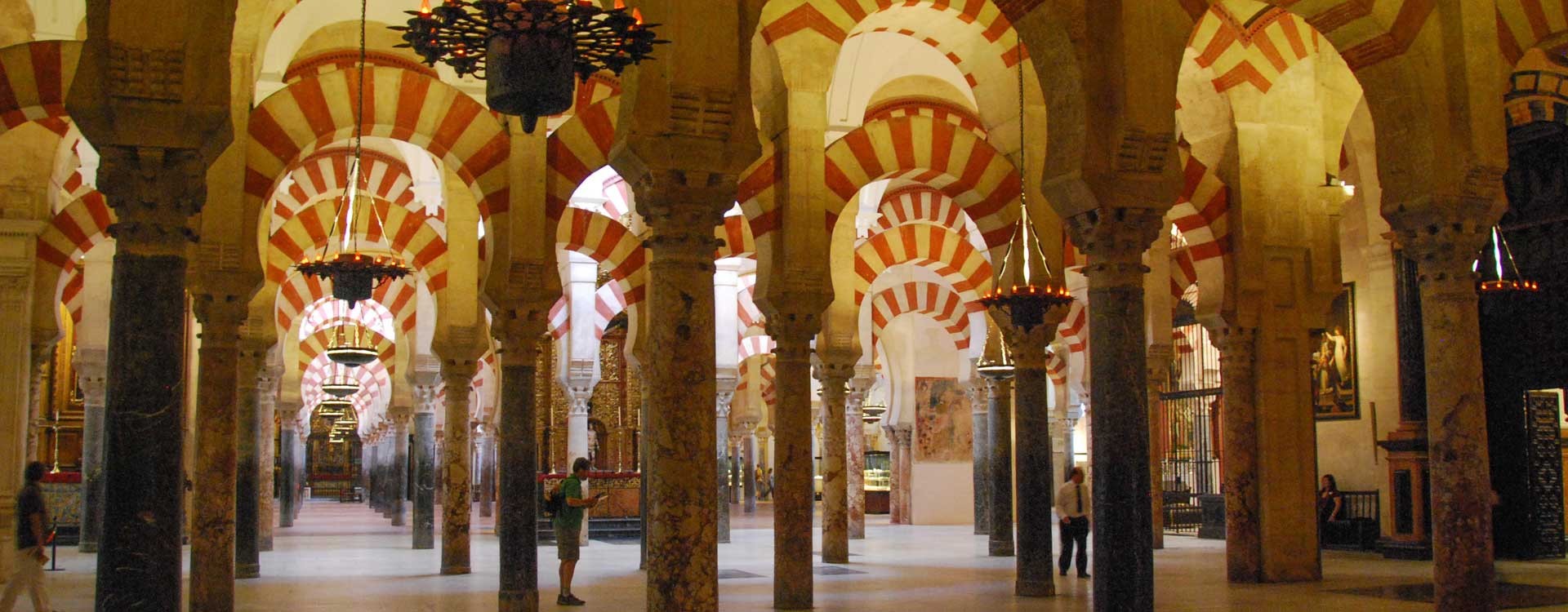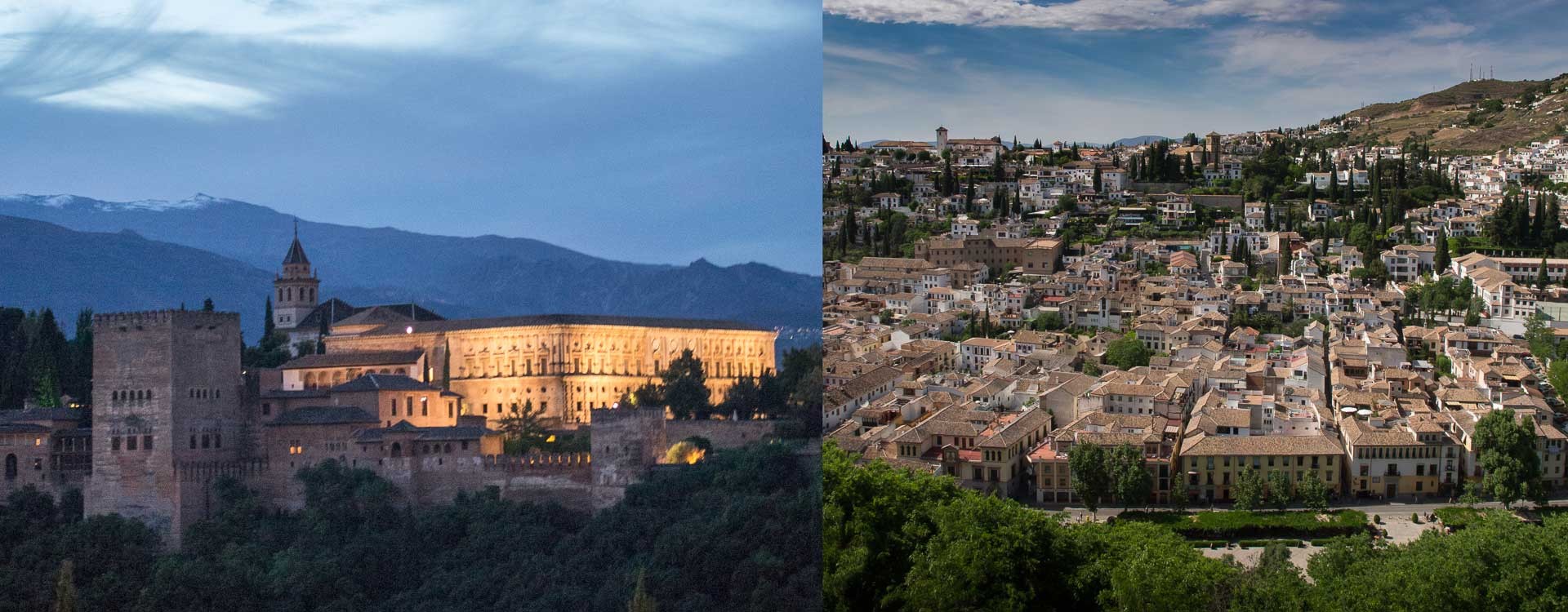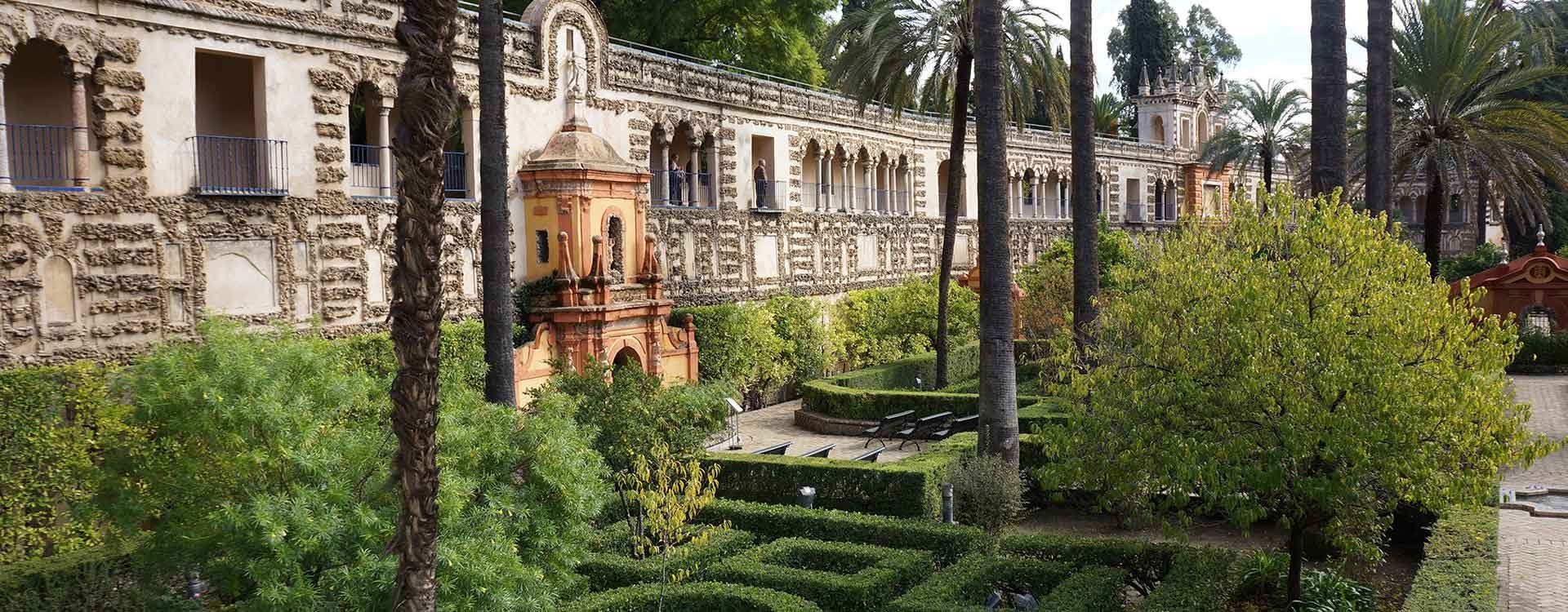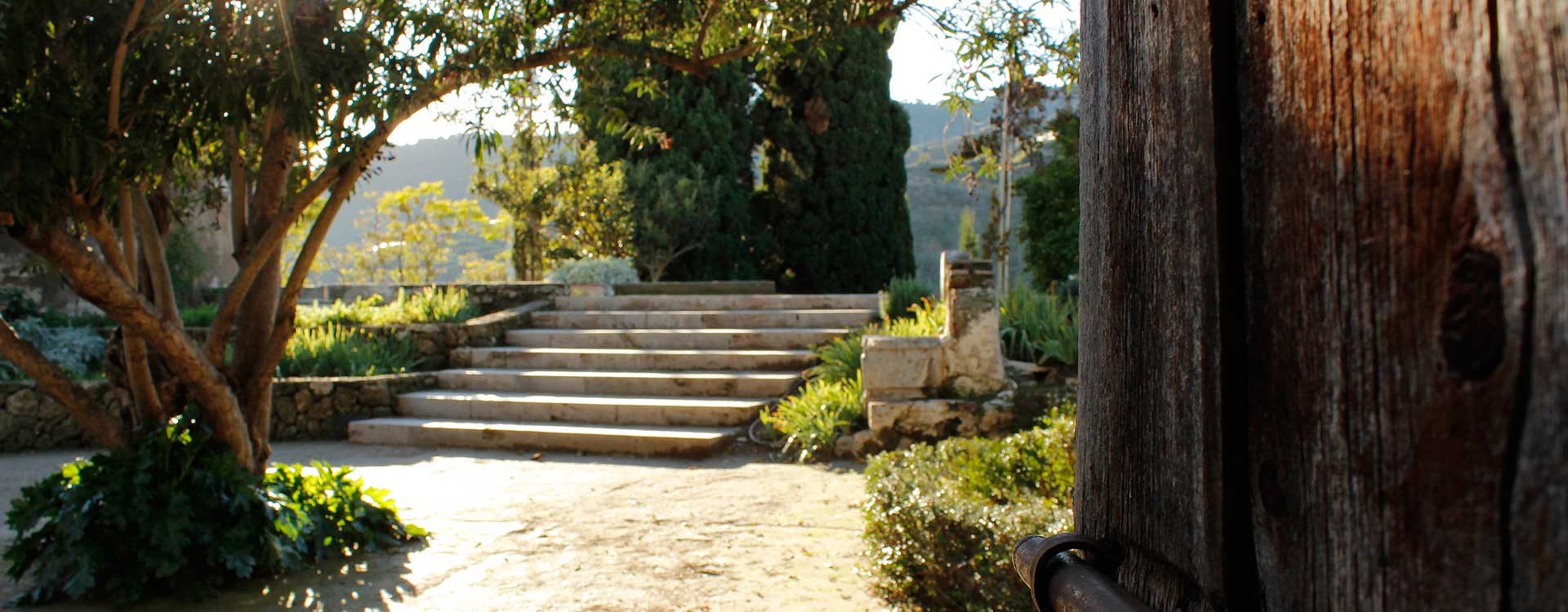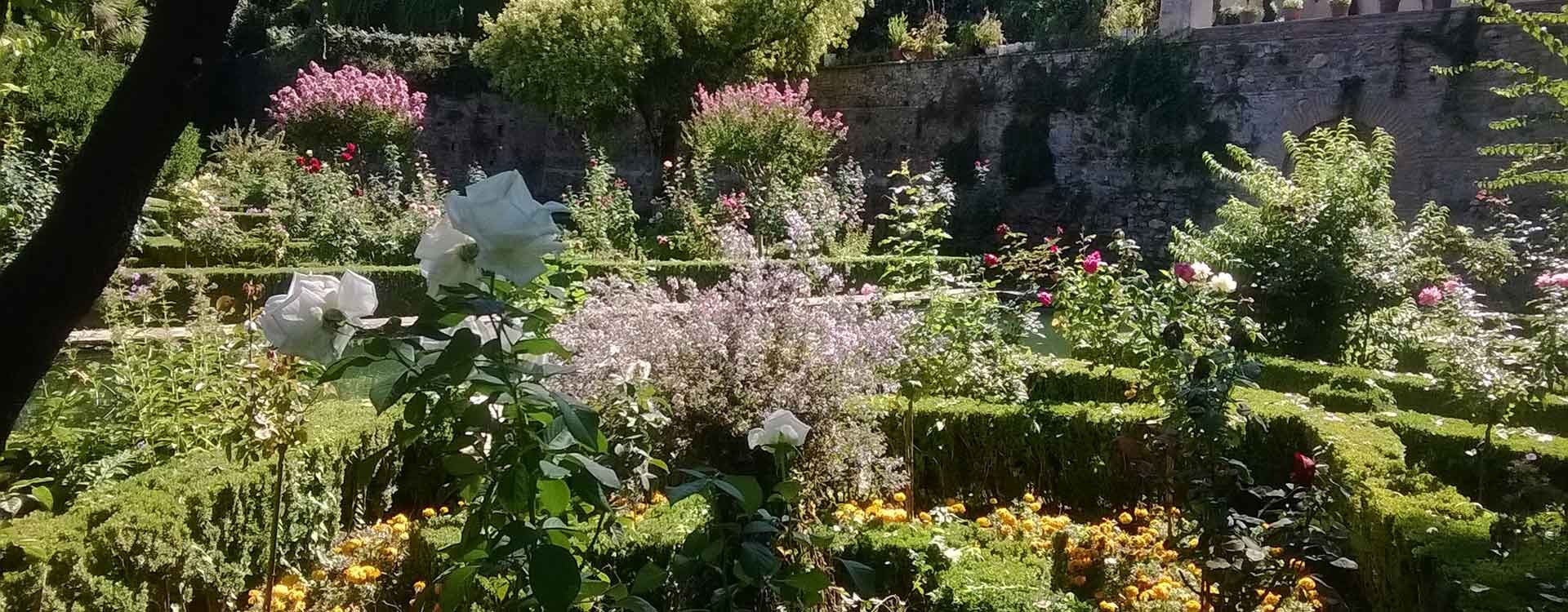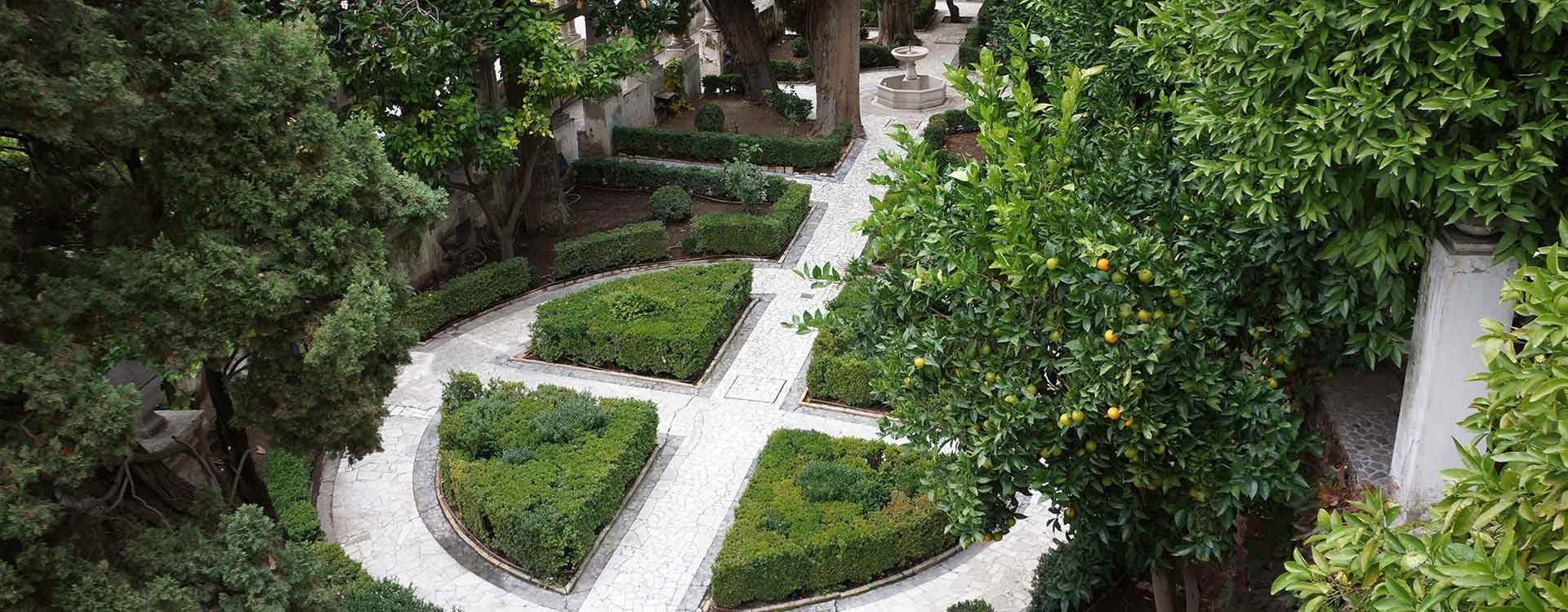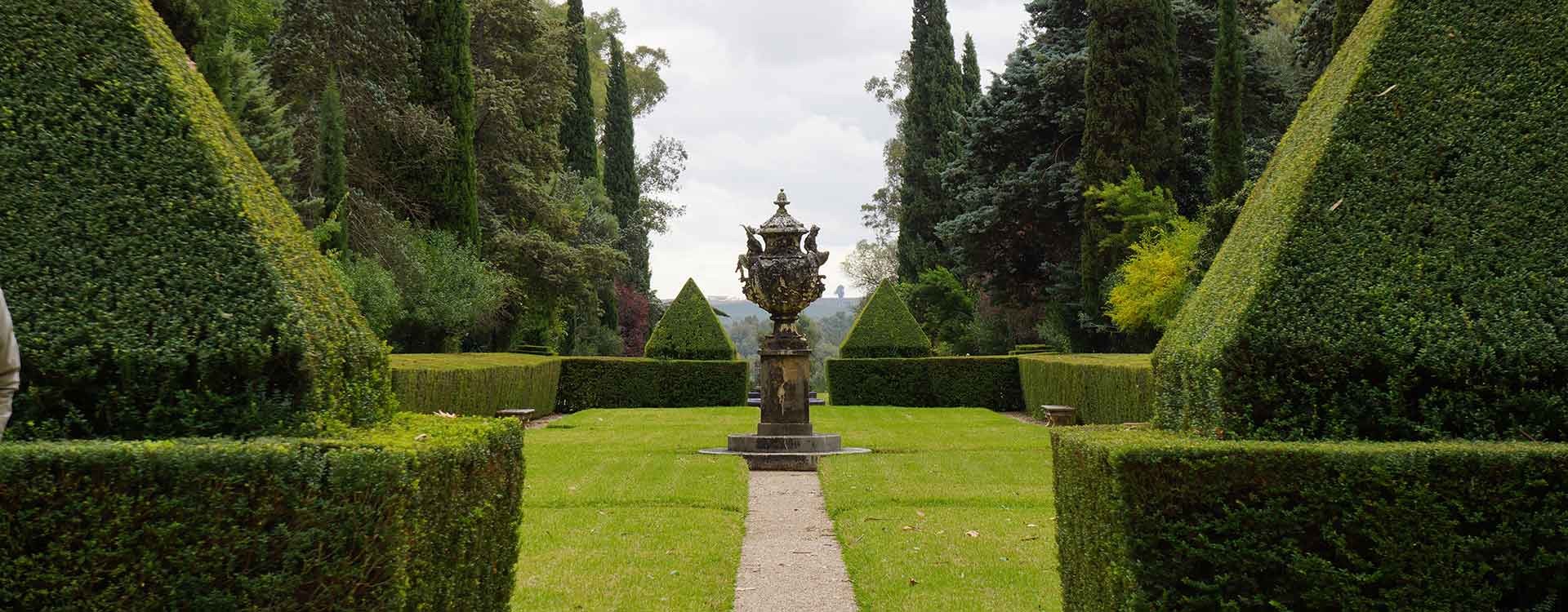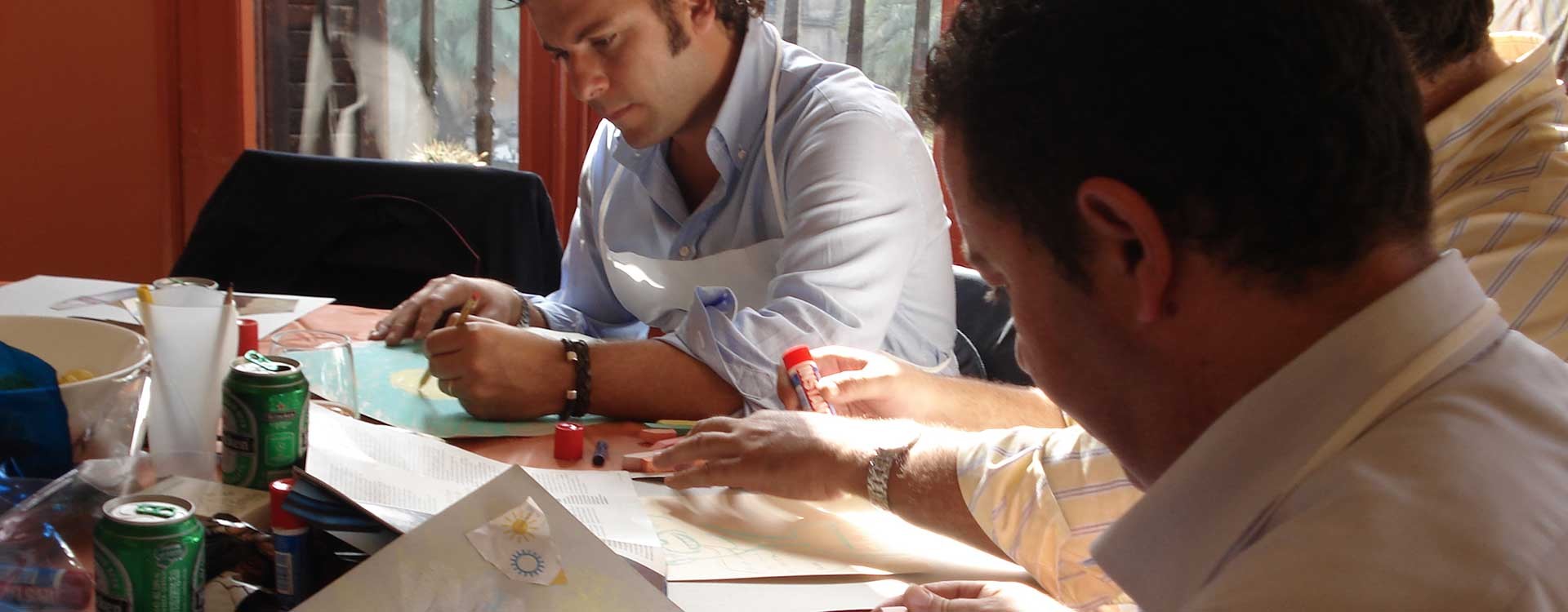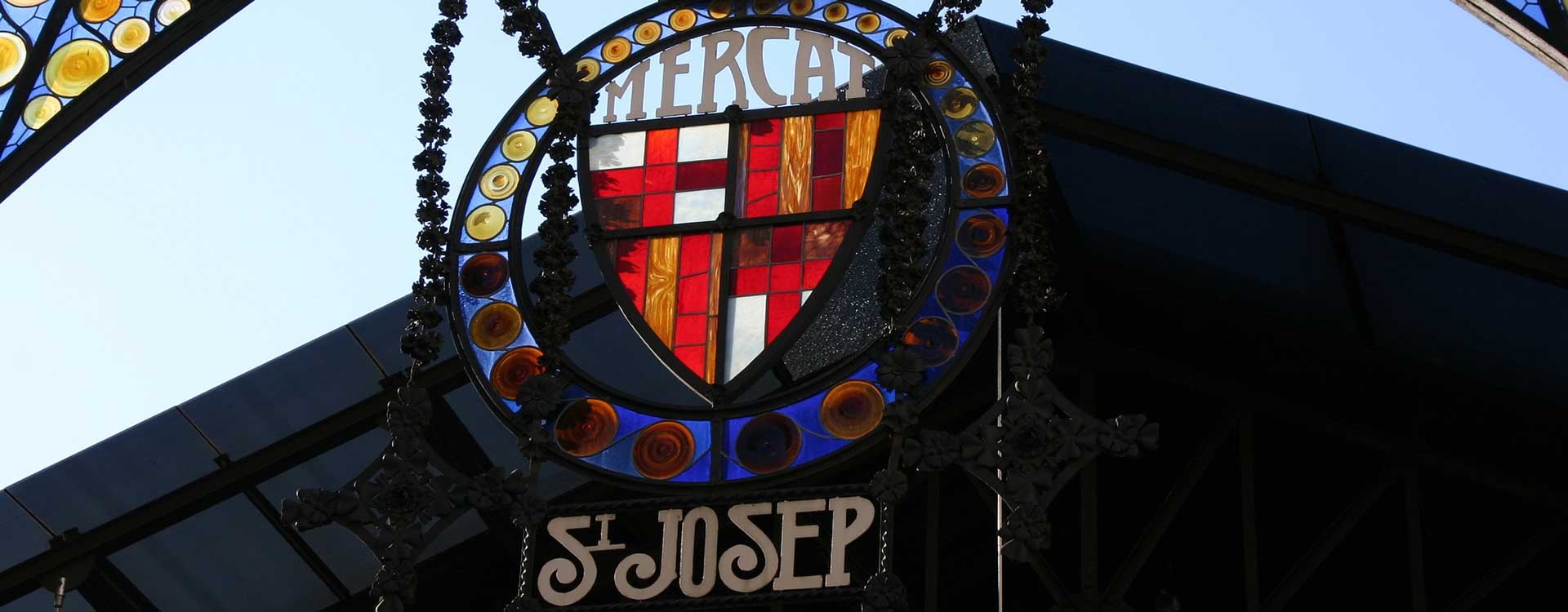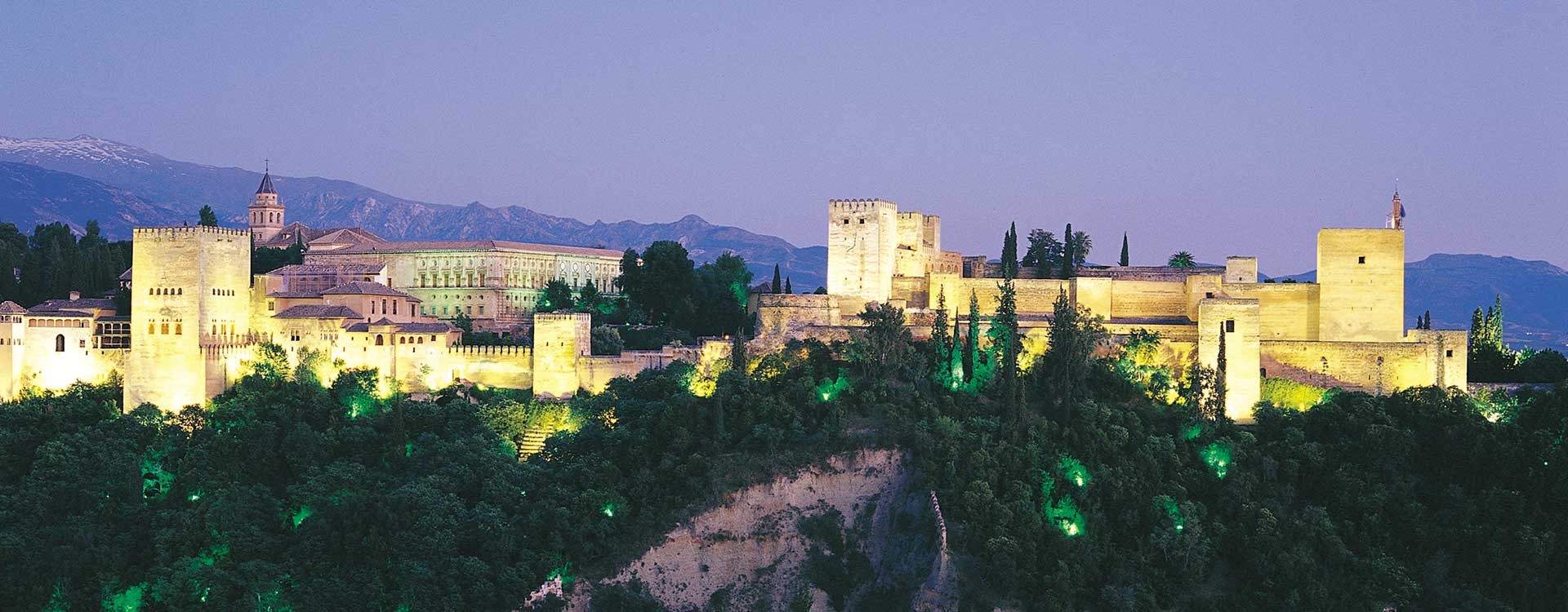Culture
Moorish Spain – sample itinerary
- Córdoba is the joining point for this tour, and is well served by the high-speed train network with AVE trains connecting the city with Madrid in 1 hour 50 minutes and Málaga in just one hour. After meeting in the hotel with your Tour Leader you will be taken on an Orientation Tour through the old city, which is a UNESCO World Heritage Site, before dinner in a delightful patio restaurant. As we stroll back to the hotel tonight we’ll see a bridge and remains of a temple from Roman times and walk around the perimeter of the vast c.8 mosque, its walls and towers floodlit at night.
- Today we discover the Córdoba of the turn of the last millennium, described in contemporary writings as “The Ornament of the World” on account of its cultural and civic attainments. The highlight will undoubtedly be the Great Mosque, a building unique in its fusion of religions and cultures. Our tour will also include the Judería, former Jewish Quarter of old Córdoba, with entry to a Sephardic Jewish museum and the small c. 13 synagogue. We conclude with a talk on life in c. 10 Córdoba in the relaxing surroundings of an Arab-style tea room, with our expert local guide. This evening you might like to relax in the hammam-style Arab baths, with massages of aromatherapy oils also available.
- At the height of Córdoba’s splendour in Muslim times the glittering palace city of Madinat al Zahra was built to symbolise the power of its rulers. When civil war broke out at the end of c. 10 the magnificent city was reduced to rubble by the warring factions. What we see today is the result of pain-staking recreation by archaeologists for over a century, plus an award-winning visitor centre which brings to life the city. In the afternoon we will tour two other significant monuments in Córdoba from the times of the Caliphate, the Alcazares Reales – palaces of the Christian monarchs built over Moorish remains – and the Baños Califales (the private bath-house of the Caliph).
- We head south today towards Granada, the last outpost of Islamic rule on the Iberian Peninsula. En route we will visit two imposing Moorish frontier castles, as we learn of the history of the centuries-long siege that finally led to the surrender of Granada in 1492. Life in the sultanate of Granada is the focus of a guided walk in the historic Albaicín district this afternoon, exploring this once densely populated area where estimates suggest as many as 40,000 people lived in the latter part of c. 15. As we explore its narrow streets and alleyways our guide will relate the customs of the time as well as the dramatic changes that the neighbourhood underwent upon the Christian occupation.
- After the spectacular views of the Alhambra, framed by the backdrop of the Sierra Nevada, on yesterday’s walk through the Albaicín, today we visit the complex and see it at close hand. Our guided tour will take in the Generalife gardens, the palaces of the Nasrid sultans, and the Alcazaba fortress, with free time thereafter to visit the Palace of Charles V, the gardens of El Partal, or the Hispano-Muslim Museum. This evening we venture into the distinctive Sacromonte area, to dine in a local restaurant and then see live flamenco in one of the gypsy cave houses – a special setting for this vibrant art form.
- Today is a free day, with a choice of optional small group activities. The culture of Moorish Spain is still maintained in many aspects of modern-day Spain, and these workshops all connect in one way or another with those influences. The tiles of the Alhambra are the inspiration for a Ceramic Tile Painting class in the studio of a local artist; the leather work for which Muslim Spain was famed throughout medieval Europe is the subject of a second craft activity, and the culinary influences in Spanish cuisine from the Arab world are the focus of a cookery demonstration in the kitchen of an Albaicín resident.
- We visit Ronda today, a town whose capture by the Christians in 1485 opened the way towards their conquest of Granada. Here we will see a well preserved section of Arab city walls, one of the best examples of a Muslim bath-house, and a secret stairwell, hewn out of the towering rock-face, by which the Christian troops entered Ronda. This evening in Sevilla we will walk by the floodlit cathedral, admiring the tall, slender Giralda, once the minaret to the main mosque, now the cathedral’s bell-tower. We will also depart on an evening river cruise from moorings next to the Torre de Oro, a watchtower that controlled shipping on the Guadalquivir in Moorish times.
- Our final day is devoted to Seville where the Moorish legacy, although not as tangible as in Córdoba or Granada, is nevertheless still an important cultural influence. After climbing the Giralda for great views of the city we visit the Alcázar, where we will learn of the evolution of a c. 11 Moorish palace into a sumptuous Castilian court in the mid c.14 when craftsmen forged elements of Christian and Muslim architecture to form a unique synthesis called “mudéjar”. We see modern repetitions of this later on in the Parque María Luisa where the centrepiece of the 1929 Ibero-American Expo stands, the “neo-Mudéjar” fantasy of the Plaza de España.
- There are various alternatives for onward travel from Seville: the high-speed train service links the city with Málaga (and its international airport) as well as Madrid and Barcelona; or the local airport offers flights to a variety of Spanish and European destinations. Or, of course, you may like to stay on in Seville or this region for a few more days in which case please contact us for details of our Post-Tour Extensions.
Gardens of Spain – sample itinerary
- The Mediterranean port of Málaga is the joining point for our tour. Your Tour Host will take you on an afternoon guided walk through the Alameda park with its many species of trees and plants imported to the city from around the world by generations of sea-farers. Welcome drinks and dinner in a characterful restaurant in the cathedral quarter this evening.
- On the outskirts of Málaga we visit the botanical gardens of La Concepción, with a collection of over 5,000 largely tropical plants. Indeed, this stretch of the Mediterranean is known as the “Tropical Coast” and we will pass cultivations of bananas, mangos, avocados, and the like. The town of Velez de Benaudalla has a rare preservation of a medieval Moorish garden, dating back to c.13 – 15. Its sunken flowers and shrubs, narrow walkways, the exquisite use of water as an ornamental feature take us back to a culture in which all five senses were involved in the planning and enjoyment of a garden. This evening in Granada we dine with views of the floodlit Alhambra palaces.
- We visit the Alhambra with an expert guide, focussing on the exquisite Generalife gardens which recreate Moorish styles with strong influences from the European vogues of the mid‑c. 19 and early c. 20. Afterwards we continue to the gardens of two carmenes, a style of walled garden with its origins in the Christian re-settlement of Moorish Granada, and which are now among the most distinguished properties in the city. The first is the art nouveau Carmen Rodriguez-Acosta, with delightful terraced gardens of fountains, statuary and topiary, as well as a small but significant private art collection. Nearby is the Carmen de Los Martires, landscaped in the Italianate style in the c. 19, where we find peacocks strutting through the rose beds and ornamental pools.
- The countryside of Andalusia is often described as a “sea of olives” so dominant is this crop in local agriculture. In the town of Baena we will visit one of the region’s foremost mills, parts of which date back to 1795. The Nuñez del Prado estates produce an organic crop milled using a mixture of traditional and modern techniques and which yield one of the world’s most highly-prized olive oils. Our afternoon in Córdoba takes us to the city’s fine Botanic Gardens which occupy a site along the banks of the River Guadalquivir and are considered among the best academic gardens in Spain. Dinner this evening is in a former wine warehouse, now one of the reference points of Córdoba’s gastronomy.
- In the year 950 Córdoba had a population of up to 500,000, comprising Muslims, Jews and Christians, who shared an advanced civic culture and infrastructure that earnt it the title “The Ornament of the World”. Our guide will tell us of these times as we walk around the narrow streets surrounding one of the world’s most incredible monuments, the Mosque-Cathedral. We will also visit the palace of the Alcazar, with its formal gardens laid out in the Moorish style. In the afternoon, the thirteen patio gardens of the Marquis of Viana’s house each show a different approach to this most Andalusian tradition of bringing the garden into close contact with the living quarters.
- Every year in May, Córdoba throws open its courtyards to the public, revealing a visual feast of colourful flowers, stone mosaics and striking water features as part of its celebrated Patios Festival. Tucked behind heavy iron gates for most of the year, the patios reveal their secrets and release the exotic scent of jasmine and orange blossom. Patios are a key architectural feature of Córdoba dating back to Roman times, the shade and vegetation that they offer being an essential remedy to the hot, dry climate. You will have the whole day to follow walking routes around the city, visiting both private and public buildings such as the beautiful convents of Santa Isabel de los Angeles, Las Capuchinas and Santa Maria.
- As we travel towards Seville we will see extensive agriculture as well as the landowners’ substantial haciendas and mansions We visit one of these, the romantic Palace of Moratalla, with its seven lawned terraces, fountains, mosaic motifs and lush woods, once the hunting estates of the Marquis of Viana. Close to Seville, the arboretum of El Carambolo offers us more than 600 species in its landscaped gardens, including themed gardens of aromatic, culinary and medicinal plants. We stay in the historic Santa Cruz district, quintessential Seville, the legendary birthplace of Carmen and Don Juan, where this evening you may like to stroll around the narrow lanes, stopping for drinks and tapas in some of its oldworld bars.
- This morning takes us to the extensive Parque Maria Luisa, favourite recreation spot for the people of Seville. Created in a “Moorish paradisical style”, there are ponds, fountains, lush plantings of palms, orange trees, Mediterranean pines, and stylized flower beds and with bowers hidden by vines. No less enchanting are the gardens of the Real Alcazar, which continue the architectural fusion of the palaces, with fountains and painted tiles giving the ensemble a special Moorish-Christian flavour. No visit of Seville would be complete without seeing the vast gothic Cathedral. The third largest cathedral in the world, its c. 15 architects boasted that all those who witnessed their work would “think us mad” for the scope of their ambition.
- High-speed train takes us through the vast plains of La Mancha to Madrid. We begin our exploration of the capital with a guided walking tour of the Parque Buen Retiro. Known as the lungs of the city, the vast park contributes a large percentage of the city’s 250,000 trees and features a c. 18 parterre and a rose garden decorated with fountains and statues. Close by are the Royal Botanical Gardens, designed in the c. 18 to teach Botany, exhibit plants and promote expeditions for the discovery and classification of new species. Time this evening to enjoy strolling through the lively streets of the Plaza Santa Ana district in a city that has a proud reputation for its sociability.
- An excursion north from Madrid, crossing the Sierra de Guadarrama, takes us to La Granja de San Ildefonso, built in 1724 as the retirement home for Philip V. Extending over 1,500 acres, the gardens are one of the best examples of 18th-century European garden design. Their French architect, Rene Carlier, used the natural slope from the mountains to the palace grounds both as an aid for visual perspective and to gain sufficient head to allow water to shoot out of the twenty-six sculptural fountains that decorate his parterres. Water is also a central motif of the city of Segovia, which we visit this afternoon. Still standing to this day, its aqueduct is one of the finest Roman monuments in all Europe.
- Let us help you with your arrangements for further travel in Spain or transfers to Madrid Airport for the flight home. We also offer, for those who would like to stay on in Madrid for a few more days, hotel and activity packages — ask us for details of our Post-Tour Extensions.
Spain Creative – sample itinerary
- After independent arrival into Málaga Airport our journey begins – as it will end – with Pablo Picasso. The city where the great artist was born boasts a small but fine collection of his early work in a new museum near the Roman amphitheatre in the historic centre of Málaga. There is also time to look around the collection of the Carmen Thyssen gallery before we head by private coach to Granada, our base for the next three nights. After a brief orientation walk, to give you your bearings, we will enjoy an early dinner in a local restaurant in the city centre.
- Situated on facing hills are Granada’s twin UNESCO World Heritage Sites — the Albaicín and the Alhambra. The Albaicín is a cat’s‑cradle of narrow streets and alleyways that represent a unique vestige of medieval Hispano-Muslim Spain. The Alhambra, the palatial city of the Nasrid sultans, is the crown jewel of this brilliant history. We will be shown both by expert guides, who will place them in context and give emphasis to the incredible craft and sophisticated designs of the period. We explore the Albaicín in the late afternoon, dine in the gardens of a neighbourhood restaurant, and then visit the palaces at night when numbers of visitors are far fewer and their magic is pervasive.
- We return this morning for a longer look at the whole Alhambra complex of palaces, fortress, urban areas and gardens. Begun in the mid c. 14, this was the work of the Nasrid dynasty whose 250 year reign in Granada proved to be the swansong of Muslim rule on the Iberian Peninsula. The exquisite Generalife gardens are a recreation of Moorish styles heavily influenced by the European vogues of the mid c. 19 and early c. 20, representing an intriguing and unique synthesis of styles. In the afternoon, you will work in mini-groups on the first of your creative activities, either Ceramic Tile Painting or Andalusí Leather Craft. For details, see below, “Creative Activities”.
- Resuming the Creative Activities, you will swap to the other workshop/class this morning, collecting at the end your finished works. After free time to further explore the city, perhaps the magnificent Royal Chapel, burial place of the Catholic Monarchs, we will spend the afternoon in a hammam (recreation of an Arab bathhouse). The Andalusí style decoration, Arab music gently playing in the background, and the soft light and drowsy warmth all make for an ideal way to unwind. Supple and relaxed you will then be shown some of the basic steps of flamenco in a fun class before rounding off the day seeing professionals showing how it’s (really!) done, in the unique setting of a Sacromonte cave house.
- Like Granada, the city of Córdoba is a treasure-trove of Spain´s history, from Roman times onwards. At the height of its powers the Caliphate of Córdoba (756−1013) was referred to as the “ornament of the world”. As we visit the Great Mosque, and the old Jewish ghetto with one of Spain’s few surviving former synagogues, we will learn about the relations in medieval Córdoba between Muslims, Jews and Christians. After a late lunch we board the high-speed AVE train that, in just over 4 hours, will have us in Barcelona, a distinctly different part of the Iberian mosaic. The Catalan capital, one of Europe’s most elegant cities, is our home for the following three nights.
- Barcelona provides a strong contrast with Andalusia, with a “modern” European and distinctly sophisticated face which wins fans from all over the world. Its lively arts scene, an infrastructure boosted immeasurably by the 1992 Olympic Games, and a proud Catalan sense of identity, all make for a fascinating city to explore. Our local guide will bring these strands together in a full day tour, seeing the works of the legendary Modernist architect, Antoni Gaudi. His unfinished masterpiece, the basilica La Sagrada Familia, will undoubtedly be a highlight of the tour. We will also visit the best-known of his civic works, the houses of Casa Mila and Battló, plus the playful, imaginative Parc Guell.
- This morning we visit the immense and colourful food market of La Boquería in the company of a local chef who will show us what to look for when buying the ingredients needed for the cooking class that follows. We will learn some classic Catalan dishes such as Red Bell Pepper soup flavoured with Saffron and Cod, and typical desserts like Crema Catalana. Lunch, tasting all four courses prepared, rounds off the experience and there are printed recipe sheets to take away too. The rest of the day is for a well-earned siesta and then perhaps an evening bar-hopping in Barcelona, sampling the multitude of local and national tapas dishes, or dining in one of the city’s top-notch restaurants.
- Picasso spent his formative years in Barcelona and the museum here holds probably the most complete collection of his works. After a guided visit with an expert guide and suitably inspired (!) we will spend the rest of the morning in a light and spacious art studio giving free rein to our creative side with a painting workshop. For details, see below, “Creative Activities”. The rest of the day is free to further explore such sights as the Barri Gotic (the medieval quarter), the boulevard of Las Ramblas where all the world meets, the Port Olympic complex, and perhaps take the cable car up to Montjuic for superb panoramic views over the city and the Mediterranean.
- Today we say our farewells before embarking on the journey home or onward travels. Or, you might like to extend your stay in Catalonia with a few more nights in Barcelona, Girona or Tarragona: please ask us about our Post-Tour Extensions..
Creative Activities
-
Ceramic Tile Painting
In an absorbing 3 hour class you will learn how to hand-paint ceramic tiles under the guidance and inspiration of a local artist. Suitable for all levels of artistic aptitude, this is a great activity for children and adults alike, and takes place in the artist’s studio in her family home on the slopes of the Alhambra. The tiles you paint are yours to take away – a unique souvenir of Granada.
-
Leather Craft Workshop
Learn about the ancient craft of leather tooling and stamping in this creative workshop, given by an American resident of Granada who has recovered one of Spain’s most traditional crafts, with its roots in the eight centuries of Muslim history, al-Ándalus. You will be shown techniques for hand carving and stamping leather with traditional designs, and then make small item in leather, such as an iPhone cover, bracelet or drinks coasters.
-
Picasso Painting Class
Inspired by the works of Pablo Picasso and his many self-portraits, this fun workshop encourages us to examine how we see ourselves and record that impression in watercolours. Under the creative direction and guidance of an art teacher you can either give free completely rein to your imagination or take inspiration from art books and reproductions of some of the works we have seen in the earlier visit to the Picasso Museum.
